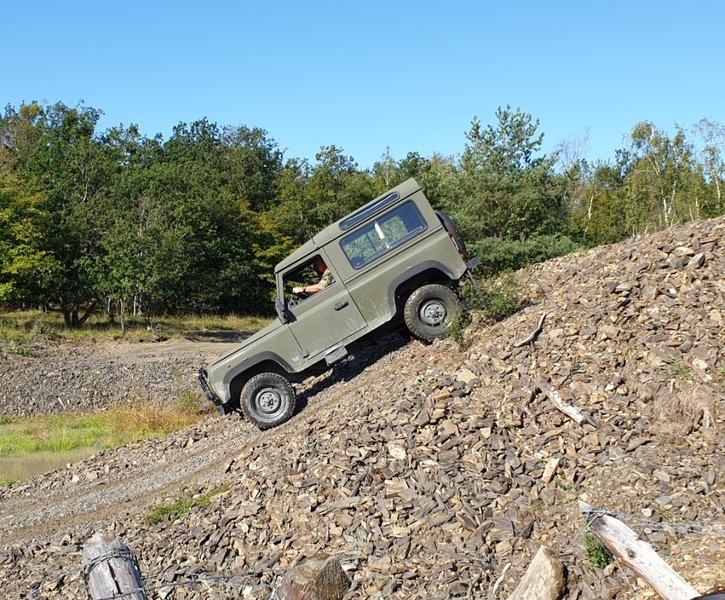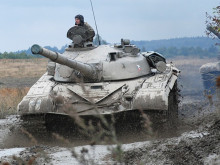Transport Education Centre: What military drivers learn in military driving school
We were curious about what our military drivers have to do, what resources they use in their training, etc., so we asked Senior Warrant Officer Radek Polda from the Centre for Traffic Education to give us a little more information about the training of drivers in the Army.

Picture: Senior Warrant Officer Radek Polda | Ministry of Defence of the Czech Republic
Senior Warrant Officer, can you introduce us to the Centre for Traffic Education, the possibilities and the equipment you have at your disposal?
The centre is simply a military driving school. It deals with the education and training of drivers of the Armed Forces and also trains instructors and teachers who deal with driver training throughout the Army. Approximately 2,500 soldiers pass through the centre annually in vocational courses. We are also the guarantor of the development of rules for driver training in the Czech Armed Forces.
We also conduct traffic prevention events for the general public, which are related to our task of fulfilling the national and departmental road safety strategy. For example, we recently attended the Kopřivnice Days of Technology, where, in addition to presenting our training equipment, we presented a demonstration of airbag operation, a safe way to break a vehicle window, proper motorcyclist equipment, or truck blind spots.
A Soldier who comes to our course can train on anything we have in the Army. The center has equipment that is currently in use by the Army. For example, Pandur II, Tatra 815 -7, Tatra 810, but also equipment that has already passed its best years. These are nowadays outdated vehicles BVP-2, UAZ and LR Defender, Tatra 815 or Karosa bus. It should be added that the mentioned equipment reaches the "age" of 30 years or more. This then requires our instructors to take extra care to keep it in working order. In spite of the above, we are able to provide training and thus fulfill our mission.
 Picture: A soldier who comes to our course can undergo training on anything we have in the Army. The centre has equipment that is currently in use in the Czech Armed Forces. | Ministry of Defence of the Czech Republic
Picture: A soldier who comes to our course can undergo training on anything we have in the Army. The centre has equipment that is currently in use in the Czech Armed Forces. | Ministry of Defence of the Czech Republic
What courses or refresher courses are you most interested in?
Even if we worked 24 hours a day, we are not able to meet the demand that is for all types of courses. There is a lot of interest in both civilian and military driving courses. For example, there are courses to obtain Group C and CE driving licences and courses to obtain a certificate to drive armed forces vehicles for all types of vehicles, from a Land Rover to a tank.
Do you have the capacity to meet the demand? Adverts for recruitment of Czech Army’s drivers are seen virtually across the whole of the Army.
Generally speaking, we are able to cover up to 70% of demand under normal circumstances. However, considering the present situation resonating throughout the society (in view of the COVID-19 measure), even the Centre has had to scale down its teaching and training activities and even suspend it at some point. This, of course, creates a great excess of demand and the task ahead is to train as many drivers of all categories as possible, without, of course, compromising on quality.
Are you planning any courses on the maintenance and operation of new Toyota Hilux vehicles?
Of course. As part of the course for obtaining an OŘVOS (certificate for driving vehicles of the armed forces) for LR Defender and UAZ vehicles, this will be extended to the Toyota Hilux. In this course, drivers will gain the basic knowledge and skills to drive the vehicle on the road, off-road, basic maintenance and minor troubleshooting. We are also prepared to prepare a brief driver's manual for the vehicle, as we have done in the past for other equipment introduced into the Czech Armed Forces.
 Picture: Approximately 2,500 soldiers a year go through the Transport Education Centre in professional courses | Ministry of Defence of the Czech Republic
Picture: Approximately 2,500 soldiers a year go through the Transport Education Centre in professional courses | Ministry of Defence of the Czech Republic
What do you see as the biggest difference between military drivers and civilian drivers, what is different for a soldier in terms of driving skills?
This is a question I answer very often. I have some experience driving in civilian life, so I can judge what different requirements are placed on civilian drivers and military drivers.
- A military driver must be able to operate the vehicle both on the road and off-road, where he must be able to overcome specific obstacles
- A military driver must be able to operate the vehicle both on the road and off-road, where he must be able to overcome specific obstacles
- A military driver is able to drive a vehicle using infrared equipment
- The military driver is able to identify a fault on the vehicle and rectify it himself
- When you're in a car accident, you want a military driver to be around to save your life;
In addition to the above, the military driver also performs other tasks within the unit, meaning that he is not only behind the wheel, but also takes part in other training.
Do you also use professionals from other security forces or rally drivers to train Czech Army’s drivers?
We cooperate with the Czech Police in the training courses. This involves cooperation in training, for example, drivers of vehicles with the right of priority.
During special training, drivers of the Czech Army can use civilian safe driving centres. Here they can try out driving on a polygon with training for crisis situations on a sliding surface with a skid plate. These facilities are staffed by experienced safe driving instructors, who are also recruited from drivers with motor sport experience. My dream is to build a similar polygon within the Czech Army training facility.
What is the procedure for training in driving the heaviest combat equipment?
The training procedure for the heaviest combat equipment is not fundamentally different from training for any other equipment. Of course, according to the developed curricula and methodological procedures, the specifics of individual vehicles are addressed. These specifics include fundamental differences such as vehicle dimensions, weight, the use of tracks, if the vehicle is floating, if it overcomes a water obstacle by wading or driving underwater. Each time we complete the course we get a driver who can operate the required vehicle, whether it is a UAZ or a PANDUR II.
 Picture: After the course, we always get a driver who can operate the required vehicle, whether it is a UAZ or a PANDUR II | Ministry of Defence of the Czech Republic
Picture: After the course, we always get a driver who can operate the required vehicle, whether it is a UAZ or a PANDUR II | Ministry of Defence of the Czech Republic
Is the so-called military driving licence, obtained in the Czech Armed Forces, also valid in civilian life?
Again, a very frequent question. How is it then? Every military driver must hold a driving licence for a given group and as a "superstructure" is the already mentioned OŘVOS (in the old way "military driving licence"). This means that a military truck driver, after obtaining a civilian driver's license, will undergo a military "truck" course to gain knowledge and skills in off-road driving, use of special equipment, and other specifics of military vehicle operation.
For combat vehicle drivers, then, it is very similar. In any case, to drive armed forces vehicles, the driver must hold both documents. There are also opinions that this 'superstructure' is unnecessary and that it does not work that way in civilian life. However, this is not true. Even a civilian truck driver undergoes training in order to hold a professional driver's licence. He or she must then attend recurrent training to the extent prescribed.
How often are holders of military driving licences re-tested and to what extent?
As part of driver improvement training, the commander may order a checking exercise. This checking exercise is precisely described in the specialised regulations. It is a driving exercise on a designated obstacle course for time. In addition, the commander may order a test of road traffic regulations and medical training as appropriate. However, the checking exercise is only one segment of driver improvement training. Driver improvement training is the entire set of exercises that a driver must complete during the year. The frequency of these drills depends on the driver's classification and the classroom skills met.
 Picture: There is a great interest in courses for obtaining driving licenses of groups C, CE | Ministry of Defence of the Czech Republic
Picture: There is a great interest in courses for obtaining driving licenses of groups C, CE | Ministry of Defence of the Czech Republic
Do you use a variety of simulations or do you prefer to practice in the field?
Nowadays, simulation simulator technology is very popular. We use Tatra 810 and Pandur II simulators for training. However, this training brings various pitfalls. For example, when a driver in the simulator feels nauseous and has to leave the simulator after five minutes. Further, these technologies age rapidly and it is very costly to keep these devices in working order. Our legislation allows, under certain conditions, the substitution of driving in a simulator for a certain part of driving training in a vehicle.
As an instructor, I prefer driving in the field because even the best simulation does not replace the need to find the best route through the terrain and navigate obstacles.
Are you planning any more skills competitions before the end of the year? Who do you think has achieved the best results across Czech Army’s units in recent years?
Unfortunately, we don't plan to. We had to cancel the "Best Driver of the Czech Army" competition, which is held under the auspices of the National Defence Service, this year due to anti-epidemic measures. When asked who achieves the best results in the competition, you will not hear from me that it is drivers from Strakonice, for example. In individual disciplines, drivers from all over the Czech Republic take the top places. There are certainly individualities, but to say that there are the best drivers in any one department is really impossible.




















